
MAY CONTAIN NUTS

Search Shorpy
SHORPY ART

Framed or unframed, desk size to sofa size, printed by us in Arizona and Alabama since 2007. Explore now.
Join and Share
Ad-Free Shorpy
Shorpy is funded by you. Patreon contributors get an ad-free experience.
Learn more.

Recent comments
- Party of Eight?
- Good choice
- Recent view
- Hudson’s Big Store
- Say what??
- Grapes?!
- Just a Great photograph.
- A Beautiful Moment
- Such joy
- Bethune-Cookman University today
- Yellow sky at morning
- Side Winder
- Air Quality?
- Sojourner Truth riot
- None were so blind(ed)
- The less famous sister
- Good ol' days?
- Rise and Fall
- Goo Goo Ga Joob
- Ticket Retention
- Not the only one
- Vagaries of War
- Killed by Amtrak
- Back to the Future
- Wanted --
- If you can't stand the light
- Centralized Traffic Control, I believe
- What's really happening
- Heckuva remote control!
- Sometimes — Things Go Bump!
Member Photos
The Shorpy
Print Emporium
Print Emporium
Search Shorpy
Search results -- 30 results per page
- A Place in the Sun: 1964
- ... eye was Red Norvo.
He brought the vibraphone to the jazz genre; an instrument I came to love.
I wanted to make sure Red wasn't ... Posted by rsyung - 06/28/2015 - 10:16pm -
![A Place in the Sun: 1964 Another Las Vegas Kodachrome taken by my dad in June 1964. View full size.
Marquee small printName recognition drops off considerably after the talented and very beautiful Ms. Carr. But Sonny King had sufficient notoriety to justify third-banana sizing and a Wikipedia entry.
Where's my time machine when I need it?Oh to be able to see some of those shows!
Yabba Dabba DoWhile for born-and-bred Americans of a certain age these photos really bring back memories, the only connection I can make is to the well-loved cartoon The Flintstones, a ray of sunshine, one of the few that embellished our lives in communist Romania. I was very young back then, but I soon began to realize the sitcom was in fact a parody of the American way of life. Probably this cartoon was the reason why I was so adamant about choosing to learn English,(a language that was just being introduced in schools) over French, which was the most popular.
Enjoying ThesePhotos of old LV. Some observations... A nice spread of makes and models of cars of the time. I notice the Buick pulling the camper, back before you needed an F350 diesel to pull a pop up camper. Finally, is there any way to see what the front license plate on the Buick says? It doesn't seem to be a normal plate.
First StopWe would drive by later in a '68 Coronet Wagon pulling a 20' Aristocrat trailer. That night, we'd stay in a KOA-type place at the (then) end of the strip. This would be the first night of one our trips to Bryce, Zion, Cedar Breaks, Arches and all the other drop-dead gorgeous parks of the Nevada/Utah/Four Corners area.
Saw that show!Or, more precisely, the one probably two years later. Anyway, my family went to a dinner show at the Sands featuring Red Skelton, but it had to have been 1966. Can't remember the opening act. Well, I was 6, for heaven's sake. We stayed across the street at the Dunes, which isn't there anymore either.
Fort Lauderdale, FloridaTo this day, Florida only requires a license tag on the back of the car. You are free to place anything you liked on the front, which is often a free billboard for your favorite radio station, or for the dealership from which said car was purchased.
[Referring to the Buick license plate, presumably. -tterrace]
LurkingWonder what the vehicle is to the right of the main sign Looks older or maybe a shuttle bus? Overall, much different then The Strip today. Well taken,
I'm not old enough to have attended many of those showsThey were adult-oriented, like the town was back in the day. If I could go back in the time machine and see the Rat Pack, that would be great.
Thanks rsyung, for yet more superb color pictures.
Only the sign remains!These early L.V. casino joints were alleged to be rife with mob corruption, more or less "cleaned out in the 80's and 90's. Of The Sands, only the sign remains at an attraction of old, huge casino signs, way out in the desert. It costs a small fortune to go see the signs, which after all, were one of the biggest attractions in the day.
Did Red go Blue? Did Red Skelton do a blue show when he worked Vegas?
Red was never blue on stageResponding to Bazinga, Red Skelton's stage shows were always suitable for the family. He reserved his seamier stories for smaller, informal audiences. But when those occasions arose, he would enthusiastically perform free for audiences as small as one person on the street.
About the Sandshttp://johnnysjoint.angelfire.com/SandsHotel2.html
The name that really caught my eyewas Red Norvo.
He brought the vibraphone to the jazz genre; an instrument I came to love.
I wanted to make sure Red wasn't forgotten!
(ShorpyBlog, Member Gallery)](https://www.shorpy.com/files/images/LVjune64dd.thumbnail.jpg)
- Blond Ambition: 1946
- July 1946. New York. "Doris Day at the Aquarium, jazz club on Seventh Avenue." Medium format negative by William Gottlieb for ... Posted by Dave - 01/23/2019 - 2:09pm -
![Blond Ambition: 1946 July 1946. New York. "Doris Day at the Aquarium, jazz club on Seventh Avenue." Medium format negative by William Gottlieb for Down Beat. View full size.
Hey FrecklesIf you look very closely, you can see the freckles that movie studios developed special lenses to hide when Ms. Day appeared in the movies.
Nice to know that she is still around today at 96.
Feminine/masculineDoris is very definitely of the feminine persuasion, so shouldn't the title say "blonde ambition"?
["Blonde" is the noun used for a blond person of the feminine persuasion: Get a load of that blonde at the bar. The adjective is "blond" regardless of gender. - Dave]
Before she was ...I guess this photo taken back when Oscar Levant knew her.
I never knew... Doris Day was so beautiful.
All That Talent, All Those LooksShe then grew more talented and more stunning as she matured into old age.
Long time agoI remember being young and pretty like this. Bet she does too. It was a lot of fun.
Classy LadyI've been in love with Doris Day since the first time I ever saw her in a movie, probably in the 1950s. She is still an awesome lady and a friend to animals. A pure class act.
One-packIMHO the bare midriff look was no more attractive then than it is now. A beautiful person like Miss Day did not need to draw the viewer's eye to an expanse of blank skin.
She started with the big bands when she was 16.
Two, three, *four*In 1946 Doris Day was still singing with the Les Brown band; perhaps she's preparing to perform the immortal "Celery Stalks at Midnight."
Class ActI lived for a number of years in Carmel, California, where Ms. Day resides, and had frequent "bump intos" with her over the years. To those who do not gush all over her, and only tourists would do that, she remains gracious and low-key, as likely to chat you up in the grocery line as any other neighbor.
And though it is a superficial criterion at best, she is still pleasant to gaze upon as well.
R.I.P. Doris!:(
(The Gallery, Music, NYC, William Gottlieb)](https://www.shorpy.com/files/images/SHORPY-Doris_Day_3_0.thumbnail.jpg)
- Mayfair Restaurant: 1948
- ... Bing? There are special direct lights above where the jazz combo would sit. There's an upright bass (lying down) and two bandstands. ... Posted by Dave - 07/19/2012 - 10:19pm -
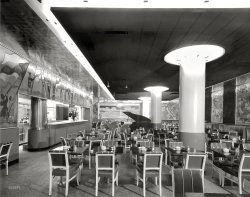
- Dakota Station: 1940
- ... I misread/misheard this as the name of the great jazz vocalist Dakota Staton. I think I assumed she took her name from a ... Posted by Dave - 12/18/2019 - 8:31pm -
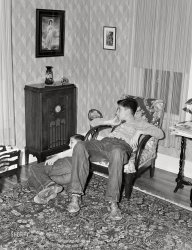
- Seafood City: 1943
- ... A long time ago I came across a photograph by Parks of a jazz musician. I think it was Milt Hinton (a great photographer in his own ... instant fan of Gordon Parks. While looking for more of his jazz musician photos, I discovered the enormous range of the man's talent. For ... Posted by Dave - 06/13/2012 - 8:19am -
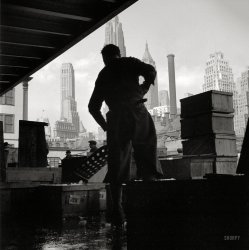
- Eight Is Enough: 1924
- ... that these faces were seen on Jay Gatsby's giant patio as jazz laced the Little Egg night.
No Lampshade? Whatever they had in the ... Posted by Dave - 09/04/2012 - 4:55pm -
![Eight Is Enough: 1924 November 18, 1924. Washington, D.C. "Debutantes of Columbia Hospital Benefit Committee." National Photo Company Collection glass negative. View full size.
Miss front row, 2nd from left....."Isn't that a great photo of all of us"?........the other 7..."Grumble, grumble, grumble, grumble........."
"The color of truth is gray"It was so much fun colorizing the Canning Club photo that i thought i'd have a go on these ladies amazing costumes .. please enjoy.
[Fantastic! Click for fabulous enlargement. - Dave]
My Oh MyLessee, Carmen Miranda, a freckle-faced Arab and a dunce cap, no less. I am at a loss for words on this one. Imagine this scene today.
End to EndBill M, you know what Dorothy Parker said (was it about debutantes in general or Bryn Mawr girls in particular) about if they were laid end to end ... she'd be surprised. Is that you were referring to? In this case (I'm ashamed to say it, as I'm not as bold as Dorothy Parker) I would definitely be surprised!
[I think Dorothy said the opposite -- she wouldn't be a bit surprised. Otherwise, not much of a joke. - Dave]
ColorizingYou have done a fabulous job colorizing this picture and the Canning Club photo. What software do you use? I have been very interested in colorizing old family photos. I really like the look of old b&w photos with some color and would like to be able to create it.
Who's whoat the Drag Party?
Second row - second from right = John Lennon
First row - second from right = TE Lawrence
Bal de Tete
Washington Post, Nov 28, 1924
Capital Society Events
Interest is growing in the Bal de Tete for the Columbia Hospital to be held at the Willard Tuesday.
Despite that a certain museum will be temporarily depleted of its treasures for the occasion, almost priceless hair ornaments removed from family vaults, heirlooms taken from attics and old trunks redolent with the odor of lavender and moth balls, there is a very close rivalry in the exhibition of all descriptions at Mrs. Hagner's social bureau at the Willard. These creations were made by the debutantes headed by Miss Beatrice McLean, and the proceeds of the sale will be added to the funds for the hospital.
...
Washington Post, Dec 3, 1924
Bal de Tete at Willard
The bal de tete at the Willard last evening for the benefit of the Columbia hospital fund was not only one of the most successful functions socially, but one of the most colorful of the many charity balls held here in many seasons. Various kinds of headdresses were worn, ranging in type from the simple Dutch cap to great crowns encrusted with reproductions of crown jewels. Graceful and extravagant headdresses of feathers, pearls, gold and silver cloth, were worn with dignity by society matrons, while the debutantes achieved great beauty with Spanish mantillas, bandeaux and other interesting ornamentations.
...
Speak easy, girlsI know it was the Prohibition, but several of these girls look more than a little pie-eyed to me.
Deb CynicismPardon my negativity, but I'd like to join Dorothy Parker and other deb-needlers by saying that if you were to change the caption to "Photo by Diane Arbus", it would put a whole new light on this one.
What Jay SawI fantasize that these faces were seen on Jay Gatsby's giant patio as jazz laced the Little Egg night.
No Lampshade?Whatever they had in the punch, it was effective. Especially on the one front row left.
Water Based PhotoshopBasically the only software that i used to colorize those photos was Photoshop. If you want more information on the techniques i used you can email me at pmadcow@comcast.net
(The Gallery, D.C., Natl Photo)](https://www.shorpy.com/files/images/12617u.thumbnail.jpg)
- Nightspot: 1941
- ... and is now seen as one of the great pioneers of blues/jazz guitar.
The woman in the mirror is beautiful. I wonder if she's a ... Posted by Dave - 09/13/2011 - 2:02pm -
![Nightspot: 1941 April 1941. "Entertainers at South Side tavern. Chicago, Illinois." Safety negative by Russell Lee for the Farm Security Administration. View full size.
Martin Dreadnaught!What I wouldn't give to have the guitar being played by the man in the center! Built by the C.F. Martin Company of Nazareth, Pennsylvania, it's a D-18. Hank Williams, Elvis, and other too numerous to mention played something similar.
LonnieCould the guitarist on the right possibly be Lonnie Johnson? He'd have been 42 at the time, and was I believe based in Chicago in the early Forties. Looks a lot like him anyway.
No reason for the photographer to know that he was snapping someone who'd played with Armstrong and Ellington, and is now seen as one of the great pioneers of blues/jazz guitar.
The woman in the mirroris beautiful. I wonder if she's a partygoer or an employee? Sure wish we had sound with these pictures!
The CrowdStylishly well dressed and enjoying the show.
Classy Good TimesI don't think you can find places like this anymore where class and dignity upgrade the enjoyment of the music, cocktails and fun. I like the lady in the fedora in the back booth looking directly at the camera like she knows more than most and the elegance displayed by all the good company present. Don't know why, but it brings to mind a little-known song sung by LaVern Baker (born in Chicago in 1929) called "Saved" which is a real hoot with words something like "I used to smoke, I used to drink, I used to do the hootchy coo, but now I'm saved..." and there is a big Salvation Army drum booming in the background. I'll have to look that up and have another listen. Anyway, thank you Shorpy for the provacative photo, just another one of which takes me back to younger days. Chicago, Chicago, a toddlin' town...
GuitarsThe guitar on the left is a 28 series Martin - you can tell by the white binding. It does look like a Dreadnought size, which surprises me. Man on the right has a Martin 00-21, which Lonnie Johnson played.
LonnieMick H could be right. The resemblance to Lonnie Johnson is striking.
[More Lonnie here. - Dave]
Cool EleganceAs requested below ... A sampling of Lonnie Johnson's music from 1927-1947. I imagine he played one of these during a set. Ladies in hats and men including the musicians in suits and ties you just can't get gigs like that anymore.
She's My Mary 1939
Two Tone Stomp 1928
Nothing But Trouble
Have To Change Keys To Play These Blues 1928
Tomorrow Night 1948
Flood Water Blues 1937
Mean Old Bedbug Blues 1927
Swing Out Rhythm 1937
Playing With The Strings 1928
Jelly Roll Baker
No More Troubles Now 1930
Guitar Blues 1929
Tomorrow Night 1947
Got The Blues For The West End 1937
Pleasing You As Long As I Live 1948
Blues In My Soul 1947
(The Gallery, Chicago, Eateries & Bars, Music, Russell Lee)](https://www.shorpy.com/files/images/8c00682u.thumbnail.jpg)
- Queen of Soul: 1942-2018
- ... 76.
— New York Times
"Aretha Franklin, Jazz & Blues portfolio, 1968." Dye transfer print by Lee Friedlander. ... Posted by Dave - 05/13/2019 - 10:19am -
![Queen of Soul: 1942-2018 Aretha Franklin, universally acclaimed as the “Queen of Soul” and one of America’s greatest singers in any style, died on Thursday at her home in Detroit. She was 76.
— New York Times
"Aretha Franklin, Jazz & Blues portfolio, 1968." Dye transfer print by Lee Friedlander. Library of Congress Prints & Photographs Division. View full size.
The Queen indeedGreat picture of my favorite female recording artist. And she was never better than she was around this time, the late 60s. RIP
I was just listening to her todayOne of the best singers in my book. Not a DIVA, no matter what anyone says. Because DIVA means SPOILED. Even though she deserved to be.
Three favoritesEveryone will have their own list of favorites, here's mine:
Oh Me Oh My (I'm a Fool For You Baby)
Chain Of Fools
Until You Come Back To Me (That's What I'm Gonna Do)
Thank you for your artistry, Aretha.
Queen ArethaA nice retrospective from WQXR (New York), written just days ago.
WQXR played a tape today of her singing "Nessun Dorma", standing in for the ailing Luciano Pavarotti:
She will be missed.
UncannyWhat a talent. I put her and Ray Charles on a pedestal.
Their ability to sing in their styles and never wander off pitch has me shaking my head in appreciation.
Bless you, Aretha. And thanks!
R-E-S-P-E-C-TAretha is one of the few singers I've ever heard who could blow your butt right out of the seat in any number of genres. I'm sure if she wanted to tackle Swedish Death Metal, she'd have killed that too. If I had to list her Top 5 best songs, which is a Herculean task because there are so many to choose from, this is what I'd settle on —
1. Chain of Fools
2. Think
3. I Say a Little Prayer
4. Natural Woman
5. Rock Steady
I could fill out the rest of the Top 10 with Skylark, Respect, Since You've Been Gone, Bridge Over Troubled Water, and I Never Loved a Man (The Way I Love You). You could probably fill out a Top 50 list, if you wanted. We'll never hear the likes of that voice ever again.
Queen and KingAretha Franklin, "Queen of Soul," passes away on August 16, 2018, exactly 41 years after the death of Elvis Presley, "The King of Rock 'n' Roll". I remember that day too.
The Blues Brothers movieI have never been so riveted to a movie screen as I was when she sang 'Think' to Matt Guitar Murphy [RIP].
At that very moment, she changed the way I listen to music.
Thank you Aretha for all the sweet sounds.
Three-octave rangeMy favorites are Respect and Natural Woman.
Whew! She had a powerful, three-octave range. Thank heaven for her recordings. She will never be forgotten.
Aretha, My QueenIn a 70-year lifetime packed with music, I've had my heart stopped maybe a half dozen times. Two of those times involve Aretha: "Nessun Dorma" and "Natural Woman." Bless her memory.
I Say a Little PrayerI’ve spent the last few days listening to many hours of Aretha Franklin. I think if I had to pick my all-time fave, the one that takes me back to the summer of 1968, to being 10 years old, trying to get a sense of what the adult world of longing and devotion might be, it would be this song. I feel a shiver in my spine and my eyes feel hot every time I hear it, even now, especially now, half a century after the first time I heard it.
Fashion sense + musical tasteJust about everyone remembers the hat Aretha wore at the Obama inauguration in 2009. Equally significant was what she sang: the nineteenth century anthem "My Country 'Tis of Thee" aka "America."
Soul SurvivorExcellent article, must-read:
https://www.newyorker.com/magazine/2016/04/04/aretha-franklins-american-...
(Music)](https://www.shorpy.com/files/images/SHORPY-15931u.thumbnail.jpg)
- Newport: 1906
- ... American tribes, attracted to Newport by rumors of a jazz festival.
Summer Not sure what season this photo was taken, but ... Posted by Dave - 08/05/2012 - 3:13pm -
![Newport: 1906 Newport, Rhode Island, circa 1906. "Bellevue Avenue." 8x10 inch dry plate glass negative, Detroit Publishing Company. View full size.
Tennis Hall of FameIt's all still there, and currently the home of the International Tennis Hall of Fame and Newport Casino.
View Larger Map
TidyCarpeted mounting blocks!
Narragansett!That spear may have been thrown by Chief 'Gansett of Narragansett Beer fame!
KerfedA closer look reveals that the poles were "kerfed." The wood was sawn on the corner edges at a 45 degree angle. That includes the top of the pole. I presume it was an attempt to make the light poles a little more attractive. Haven't seen that anywhere else.
[An even closer look reveals that the poles are concrete. - Dave]
Things to comeThe man on the right with the straw hat seems to be looking at the future, a new motor car. You can just see the differential in the rear axle.
The guys on the fence to the left of the car might be waiting for spare parts to arrive to fix the new contraption.
Restless Natives!Watch out! In the trees on the left; there's one and he's got a spear!
Wampanoag, most likelyI see on the left edge, that the photographer has captured a spear in mid-flight. Probably from one of the indigenous native American tribes, attracted to Newport by rumors of a jazz festival.
SummerNot sure what season this photo was taken, but when I looked at it, I had an intense feeling of summer. Heat, bird and bug noises, soft breeze, etc. Then it was gone. Gotta get out of this office...
McKim, Mead and White—the early yearsDesigned by the soon-to-be-famous firm and built in 1880, this is not the home of the Newport Casino, it IS the Newport Casino; so named from the beginning after the Italian word for "little summer house." Nothing to do with gambling. It encloses the oldest continuously used competition grass tennis courts in the world, hosting the first U.S. Lawn Tennis Championships in 1881. Further south on Bellevue Ave. are the street entrances to some of the grandest houses ever built in the U.S., the ocean-front summer "cottages" of Gilded Age millionaires.
http://en.wikipedia.org/wiki/File:Newport_Casino.jpg
(The Gallery, DPC, Stores & Markets)](https://www.shorpy.com/files/images/4a12437a.thumbnail.jpg)
- Patriotic Gesture: 1942
- ... the salute to the flag." A few interpretations verging on Jazz Hands. 4x5 inch nitrate negative by Ralph Amdursky for the Office of War ... Posted by Dave - 01/28/2017 - 11:51pm -
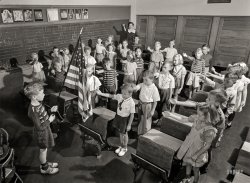
- A Sign Unto You: 1922
- ... There was a lot of bombast against dancing and so-called jazz music.
Jones' situation was probably helped by the fact that he ... Posted by Dave - 09/13/2011 - 8:24pm -
![A Sign Unto You: 1922 New York, May 1922. "Grace Methodist Episcopal Church, West 104th Street." Gutted by a five-alarm fire in 1983. Bain News Service. View full size.
Isham JonesLeading one of the most popular bands of the 1920s and 30s, Isham Jones would have a million selling record in 1921, Wabash Blues. He retired in 1936 and Woody Herman took charge of the band.
http://www.youtube.com/watch?v=kmkxc-FA5wg
A musical churchAs a Methodist and a musician, I appreciate that this is apparently a musically enlightened church. The Isham Jones orchestra was one of the most prominent of its day, rivaling that of Paul Whiteman. Also, notice the sermon topic: From Five Flats to Two Sharps. (D-Flat Major to D Major) It would be interesting to know how he made a sermon of that material.
Not exactly an "Open Door" church.I hope nobody was trapped inside when the fire broke out with those gates in place!
Must have been a pretty hip churchto have had Isham Jones and his orchestra playing! It would have been my church for sure!
Original verbageNever have seen these words "this may be your church" on a church sign before. Kind of interesting and also the open window at one of the stained glass panels.
I suppose the large signis more effective than placing a classified ad reading" "Found. One church. If yours please call 555-1212 with a description."
My neighborhood churchWell, one of them. It is located between Columbus and Amsterdam Avenues. I walk past it at least 3 times a week, and remember that fire very well. It is now a neighborhood center-cum-church with an attached apartment building. Interesting that Isham Jones' orchestra played there. That might have gotten me to church!
A joyful noiseIt was very unusual for a dance orchestra to play in a church in those days. There was a lot of bombast against dancing and so-called jazz music.
Jones' situation was probably helped by the fact that he himself had played music in his Methodist church as a boy in Saginaw, Michigan, and that his mother was the church's organist.
Can't quite read the whole signSpecifically the lighter print between "Orchestra Of Chicago" and "HEAR THEM"? I've enlarged the photo, but despite the high resolution, that part of the sign is difficult to read. Can anyone tell me what it says? Just curious!
["One of the finest Musical Organizations in the Country, costing Brunswick Co. thousands of dollars each day they spend in N.Y. making records." - Dave]
Senate ChaplainThe Saturday New York Times of May 6, 1922 had an advertisement for the service (shown below). Presumably then the Isham Jones Orchestra played at the church on Sunday May 7.
Rev. Dr. Frederick Brown Harris was born on April 10, 1883 in Worcestershire, England, and came to the United States as a child. He was ordained a Methodist minister in 1909. After two other pastorates, he came to this church in 1918. In 1924 he became the pastor of the Foundry United Methodist Church, in Washington, D.C., where he would remain until he retired in 1955.
Rev. Harris became the Chaplain to the U.S. Senate on October 10, 1942. This lasted until January 4, 1947. After the sudden death of his successor, Rev. Peter Marshall in January 1949, Harris was again appointed U.S. Senate Chaplain. This tenure lasted from February 3, 1949 to January 9, 1969. During his life Harris conducted the funeral services for President Herbert Hoover, Senator Robert A. Taft, and General Douglas MacArthur. He died on August 18, 1970. He remains the longest serving Senate Chaplain (24 years total).
(The Gallery, G.G. Bain, NYC)](https://www.shorpy.com/files/images/34214u.thumbnail.jpg)
- Anita O'Day: 1958
- ... Shown here in the same year as her remarkable Newport Jazz Festival performance, as immortalized in the movie Jazz On A Summer's Day.
The Amazing Anita O'Day Newport ... Posted by Dave - 04/29/2016 - 6:08pm -
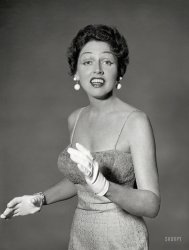
- The Red Caboose: 1943
- ... player named Paquito d'Rivera. The music was more or less jazz/classical fusion and one of the pieces was composed by Jack Delano, who ... Posted by Dave - 07/30/2012 - 10:02pm -
![The Red Caboose: 1943 Chicago & North Western RR worker putting the finishing touches on a rebuilt caboose on the rip tracks at Proviso Yard, Chicago. April 1943. View full size. 4x5 Kodachrome transparency by Jack Delano.
CabooseGreat photo, Jack takes really terrific RR pictures, has he ever contributed to Trains or Railfan magazines?
[This picture is over 60 years old ... Jack died 10 years ago at the age of 83. - Dave]
KodachromeEarly Kodachrome looked so good. Color film these days has too much contrast.
Re: Kodachromeyes, i have noticed most of the pictures taken in the 40s that i have seen on this site are more crisp than the ones taken now!
American railway jargon is aAmerican railway jargon is a bit of a mystery to me. Can you tell me what "rip tracks" are?
Rip tracksRIP track
From Wikipedia, the free encyclopedia
A RIP track (RIP is an acronym for repair in place) is a designated track or tracks in a rail yard where locomotives and/or railroad cars are set out for minor repairs without removing the units from service, sometimes without even removing a freight load from the car. In some yards, a RIP track may be used for staging locomotives or "bad order" cars for major repairs. Some yards may have more than one RIP track to serve both functions.
Jack DelanoJack Delano was not a railfan per se. I am not sure he was even particularly a photographer by trade. He was a beneficiary of government funds during the FDR era. Fortunately he was sensitive to the drama of the railroads.
Interestingly, some years ago I attended a concert by a Cuban clarinet / saxophone player named Paquito d'Rivera. The music was more or less jazz/classical fusion and one of the pieces was composed by Jack Delano, who moved to Puerto Rico after the war. So Delano was a true artist in more ways than one.
Dave Nelson
(The Gallery, Kodachromes, Chicago, Jack Delano, Railroads)](https://www.shorpy.com/files/images/1a34685u_0.thumbnail.jpg)
- Smoke and Hipsters: 1958
- ... this is so often lost to history. I especially like the jazz concert being held at 1 am on January 1, with free coffee on offer.
It ... Posted by Dave - 01/31/2018 - 2:55am -
![Smoke and Hipsters: 1958 April 1958. "The 'Beatnik' community of San Francisco's North Beach district, socializing at a local coffee house and bagel shop." (The Co-Existence Bagel Shop at Grant Avenue and Green Street.) Photo by Cal Bernstein for the Look magazine article "The Bored, the Bearded and the Beat." View full size.
Oh, what a time.My grandfather had a real estate office 2 or 3 doors down from the Bagel shop at 1356 Grant Ave. I used to visit him often when I was 10 or 11 years old and was absolutely fascinated by the folks who hung out there often there was some guy reciting poetry.
There was another joint across the street on the 1300 block of Grant which was popular among the "artsy" crowd in those days, too, but I can't remember its name. It was next door to Figone Hardware.
Waiting to be DiscoveredI'm guessing Sidney Poitier and Ali MacGraw.
[Sidney was already a star in 1958. But look, there's Ralph Meeker! - Dave]
Crazy, manI guess Bagels hanging from the ceiling was a happening thing in these Hipster joints.
Rainier AleA.k.a. the Green Death, an old favorite of mine. I haven't been able to find Rainier Ale for the last two years. Originally a Seattle brand, it was last being brewed at the Miller plant in Irwindale, California.
Self-Marginalized YouthActually the word Beatnik was a writer's invention that stuck in the public's mind. The disaffected youth and ex-soldiers of the day who felt like outsiders called themselves “hipsters,” or sometimes “beats.” The term “beatnik” wasn’t coined until 1957-8 when a magazine writer came up with the term. He combined “beat” with the Space Age Russian word “Sputnik.” In Europe a similar group of young people were called "young Bohemians." They lolled on the banks of the Seine drinking coffee, eating bread and cheese, reading Marx, living off money from home, waiting for the proletarian revolution to start.
Investment in the makingThe posters on this wall would bring a pretty penny on the collector's market nowadays. There's no shortage of well-heeled people with a nostalgic affection for their bohemian and radical youth.
Ten years laterTheir male counterparts would have hair as long as the women and you wouldn't see men as nicely groomed as those in this photo. These people would be seen as those who couldn't be trusted as they would be over 30 by then. They are however the vanguard of what came to be known as the New Left.
Free coffeeWonderful that the posters and signs on the wall have been preserved in this photo - ephemera like this is so often lost to history. I especially like the jazz concert being held at 1 am on January 1, with free coffee on offer.
It just HAD to be there -- the pennant "BE SQUARE," man.
Bagels Be GoneSame street corner, then and today. The Co-Existence Bagel Shop has been replaced by Henry's Hunan cuisine restaurant. This neatly reflects the North Beach neighborhood's continuing evolution from Italian-American to artists/Beats/hipsters to Asian-American.
I wonder how their kids turned out?Remember, Ned Flanders' parents were beatniks.
(Eateries & Bars, LOOK, San Francisco)](https://www.shorpy.com/files/images/SHORPY-53770u.thumbnail.jpg)
- Guitar Hero: 1941
- ... the left is Lonnie Johnson, noted bluesman and pioneering jazz guitarist. Who are the others? Medium format safety negative by Russell ... Posted by Dave - 07/24/2012 - 7:14pm -
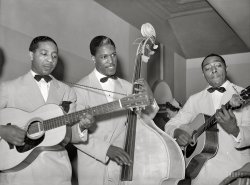
- Horsy Chapeau: 1923
- ... early 20s photos of New Orleans and can almost hear the jazz and Dixieland music in the background. Of course, by this time many of the city's jazz greats had moved on to other cities in search of fame and fortune.
... Posted by Dave - 01/22/2014 - 11:46am -
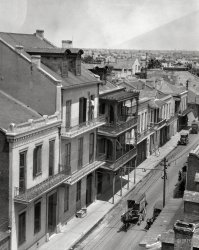
- Cool Pink: 1953
- ... the role for the movies. If you have seen "All That Jazz" she was the real life person depicted as the red red headed former wife ... Posted by Dave - 10/02/2013 - 9:42am -
![Cool Pink: 1953 May 1953. "Dancer-actress Gwen Verdon in a hammock wearing a ballgown." Color transparency from photos taken for the Look magazine assignment "Midsummer Fantasies: How to Keep Cool in a Heat Wave." View full size.
Note to self:Must remember to roll out of bed on the left!
High Above Madison AveIt took me awhile to figure out that St.Patricks is on the right and the roof of the Villiere Houses (then used by the Archdiocese of NY) are on the left.
LolaI believe at this time she was about to star in "Damn Yankees". She repeated the role for the movies. If you have seen "All That Jazz" she was the real life person depicted as the red red headed former wife of the lead. In real life she had been married to Bob Fosse.. After their marriage broke up they remained close along with Ann Rienking.
[She'd just opened in Can-Can, May 7, 1953. Damn Yankees opened May, 1955. -tterrace]
I didn't remember correctly. I did see her in "Yankees", but in '55 I was only 11, so forgive me.
"Chicago" starShe was also the original Roxie Hart in "Chicago", and she played her as a rather bedraggled floozy, not a glamor girl as in the movie version. A great performer, and a very brave lady to climb into that hammock!!
"How to Keep Cool in a Heat Wave"Step 1: Remove elbow-length satin gloves.
Not found in natureAs a former natural redhead, I always really wanted hair like that-- a color so unnatural and shocking that you couldn't forget it. The former Mrs. Bob Fosse was certainly one you couldn't forget! (Nor was he.)
The location is no coincidenceIt makes sense that this photo was for a Look magazine assignment, as she's on top of the Look building at 488 Madison Avenue. At the time it would have been only a couple of years old.
Designed by Emery Roth, the building received official landmark status a couple of years ago. Its rounded corners are reflected in the curve of the railing.
Look magazine has been gone since the early 1970s, a year or so prior to the demise of its archrival Life. Today the building houses mostly service businesses such as law and accounting firms with no real "marquee" tenants.
(The Gallery, NYC, Pretty Girls)](https://www.shorpy.com/files/images/SHORPY_03024u.thumbnail.jpg)
- Royal Castle: 1937
- ... to Frenchmen Street and the best traditional New Orleans Jazz. At the edge of the Marigny, headed down river toward the Bywater. The ... Posted by Dave - 05/22/2014 - 3:42pm -
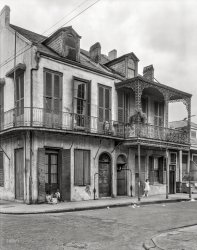
- Organ Meet: 1924
- ... costume, who would stage a kind of street performance to jazz it up a bit.
Ultimately the grinders were driven out because music ... Posted by Dave - 05/05/2020 - 3:46pm -
![Organ Meet: 1924 "Organ grinder, New Orleans, 1924." Nitrate negative by Arnold Genthe. View full size.
Offal TitleOh, man --
724 Saint Philip StThe large building on the left, across from Montalbano's Italian Grocery, is now gone, but everything else looks basically the same.
Organ Grinder Econ 101? How did one actually make a living as an organ grinder?
The Missing BuildingThe sizable gap was a building that explains the group of kids seen in the photo. It was the McDonogh Public School #15 on St. Phillip Street.
New Orleans once had more than a dozen schools numbered and called McDonogh. Why? A local history of the schools explains:
"When wealthy recluse John McDonogh died in 1850, the residents of New Orleans and
Baltimore were surprised to find themselves the beneficiaries of his considerable estate.
His will specified that the money was to be used for the purpose of establishing public
schools in the two cities for "education of the poor of all castes and races." When the
complicated details had been hammered out and the bequest had been honored, over 30
public schools bearing John McDonogh's name had been constructed in New Orleans.
Finding photos of the original McDonogh schools was more difficult than I thought it would
be. Most of the McDonogh schools were demolished and rebuilt very early on, as the
population increased and larger buildings were required. (Many of these second McDonogh
schools are still standing, more than a century later.) Some were even rebuilt a third time. "
But not McDonogh #15. Farewell ...
Where's The Monkey?The little girl appears to be looking for something.
Flora PowerThese kids undoubtedly had ironclad immune systems.
Grinding for penniesOrgan grinders made money by receiving tips for their musical performance. Many folks considered them to be only one step up from beggars. However, at that time music itself, particularly for the less fortunate, was a rare thing to hear unless one's family had talent and instruments, so the performance was actually worth spending a few pennies. Often the grinders would have a monkey or human performers with them, sometimes in costume, who would stage a kind of street performance to jazz it up a bit.
Ultimately the grinders were driven out because music licensing came into effect, effectively preventing grinders from performing the current hits, such as they were. Very few actual grind organs still exist as a result.
This fellow works a long day, since he has a lit lantern with him, foretelling his lengthy evening's work ahead.
I love the fact that the performer has stuffed his ears with cotton to dampen the deafening noise.
[I suspect the lanterns were a city requirement for carts. - Dave]
Not a Mighty WurlitzerHere's a video demonstrating what those simple pipe organs sound like along with a glimpse at how they work. https://www.youtube.com/watch?v=p_PsFtxIIcw
Another with a trove of period photographs. https://www.youtube.com/watch?v=9efnMNP-s0Q
You Too can be an Organ GrinderA quick search of the internet reveals a kit organ that is operated by hand power and a punched paper roller not unlike a player piano. This one, while new, seems a tad wheezy.
https://www.youtube.com/watch?v=p_PsFtxIIcw
Organ grinder girlThe recent run of circa 1910 photos have been wonderful: Manchester NH, Cleveland, NYC, Charleston, LA. (Not so big on the four doctors and the arthritic foot in 1949.) But I keep going back to New Orleans in 1924, on Tuesday, four days ago, to reinspect the central character (for me) that I’ve come to think of as the organ grinder girl: her face in profile, prominent nose, and a distinct spark in her step. She is so taken with the cart and maybe even the organ grinder fellow. All the other kids have something going on, too, but I have come back every day, for these past few days, as one does frequently on Shorpy, to look at this arresting girl.
(The Gallery, Arnold Genthe, Kids, New Orleans)](https://www.shorpy.com/files/images/SHORPY-7a03387a.thumbnail.jpg)
- Traveller: 1903
- ... in those straw-lined crates? Whiskey? Molasses? Jazz musicians making their way to Paris in a rather roundabout and unorthodox ... Posted by Dave - 10/11/2021 - 11:53am -

- The Cincinnati Kid
- ...
Ken Burns This image was used in the Ken Burns "Jazz" documentary.
Great photo! And the cool thing is, the boy might ... Posted by Dave - 07/21/2012 - 10:34pm -
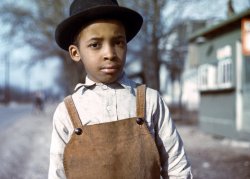
- Showtime in Chicago: 1941
- ... same in 1961 when I was producing a series of Chicago jazz sessions for Riverside Records. I took this photo then—notice Sam Cooke ... Posted by Dave - 02/11/2019 - 4:09pm -
![Showtime in Chicago: 1941 April 1941. "The movies are popular in the Negro section of Chicago. Regal Theater and Savoy Ballroom in the Southside neighborhood." Medium format negative by Russell Lee for the Farm Security Administration. View full size.
Looked the same in 1961when I was producing a series of Chicago jazz sessions for Riverside Records. I took this photo then—notice Sam Cooke and The Drifters were on the bill.
This ain't a rehearsalI know it's been said before, but I love the way people used to dress up to go out. I still dress up when I go out. You live one time; dressing up is a nod to the uniqueness of every day.
[As well as, in this case, Easter Sunday. - Dave]
All the more reason to resurrect the custom of dressing up to go out.
The first car is a 1940 Mercury. I bought one in 1968, and restored it by 1972. I used it for about 40 years, and then gifted it to a young friend who will take care of it for many years to come.
UneditedI find it sorta remarkable that on the coming attractions, the Regal found it necessary to say they’re showing GWTW with “Nothing Cut but the Price”. What, they were going to clip out the burning of Atlanta because the show ran long?? Oy gevalt!
Late ArrivalsI hope these filmgoers got a break at the box office in April of 1941. Both "The Philadelphia Story" and "Life With Henry" were released and had already been shown in movie houses in 1940.
Previously on Shorpy ...We've been to the Savoy for roller skating a couple of times.
The Coasters: 1941
Saturday Night: 1941
I hear a MeadowlarkIn addition to movies and roller skating, the Savoy also had basketball exhibitions by the Savoy Big Five, who later changed their name to the Harlem Globetrotters.
Basie at the SavoyIt looks as if Count Basie was playing the Savoy ... can you imagine?
ObservantI'm fascinated that the ones who noticed Mr. Lee are all children. So many of them are looking directly at the camera.
Also, The Philadelphia Story is worthy of many, many viewings.
(The Gallery, Cars, Trucks, Buses, Chicago, Movies, Russell Lee)](https://www.shorpy.com/files/images/SHORPY-8c00898a.thumbnail.jpg)
- Mo and Mammy: 1927
- ... little smile. Just the opposite of the parents in "The Jazz Singer."
Ida Yoelson Obit
Washington Post, Jan 9, 1951 ... Posted by Dave - 08/27/2012 - 5:05pm -
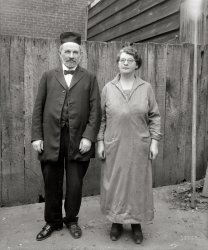
- Hats Off for Cal: 1926
- ... of course but they tended to be studio bound. "The Jazz Singer" made the sound popular, but it actually used synchronized records ... Posted by Dave - 08/07/2012 - 2:51am -
![Hats Off for Cal: 1926 May 1, 1926. President Coolidge and Boy Scouts on the South Lawn of the White House. View full size. 4x5 glass negative, National Photo Company Collection.
Friends of CalWonder who the other older gentlemen are around and behind Cal? The fellow with the beard is about old enough to be a Civil War Vet--his hat is different than the others'--also fascinating to see so many different faces in such a small space.
[The oldster with the beard is the appropriately named Daniel ("Uncle Dan") Beard, an early figure in the history of the Boy Scouts. The man in the uniform looks like BSA treasurer George D. Pratt. - Dave]
Snappy DresserGotta hand it to Cal, that's a sharp suit.
This is a very rare photo of Coolidge...He's actually smiling.
SecurityJust imagine, the President standing all alone in a huge crowd like that. It'd be unheard of nowadays.
Hand cranked camera1926 is a couple of years early for sound on film to be common. There had been experiments of course but they tended to be studio bound. "The Jazz Singer" made the sound popular, but it actually used synchronized records rather than actually recording the sound onto a track on the film. As I understand it too, you couldn't use a hand cranked camera such as the one this man is using to record sound film of any sort but particularly recording it on film, there had to be some sort of motor drive. While most cameramen were pretty good about maintaining a precise number of frames per second rate in their cranking it was never perfect. To get proper sound reproduction the film had to be projected at the same rate at which it was shot - 24 fps was eventually decided upon as the standard. The guy in the hat is probably shooting for a newsreel company.
Any ideawho is taking the movie footage? Would this be a talky or a silent film in 26? It seems that politicians even back then were looking for a photo op.
sound on film>>recording it on film, there had to be some sort of motor drive.
Doesn't the camera also need to be electrically powered, for the reason that the sound recording works by using the sound to modulate a light source... so you need to power the light bulb and associated circuitry.
RE: SecurityI believe the gentleman directly behind the President's right shoulder is the principal Secret Service Agent, Colonel Edmund W. Starling. As a footnote, Cool Cal was afraid of squirrels and rarely went into the park across the street from the White House.
(The Gallery, Boy Scouts, D.C., Natl Photo, Public Figures)](https://www.shorpy.com/files/images/15786u.thumbnail.jpg)
- Band Ahoy: 1923
- ... many of these players had a sideline in ragtime and hot jazz. Some of them certainly certainly look the part.
Unrated I'm struck ... Posted by Dave - 08/21/2012 - 12:49pm -
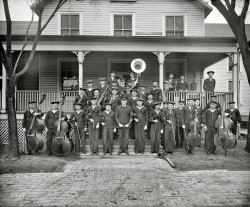
- Moonshine: 1920
- ... rendition, the hot instrumental version by Ted Lewis's Jazz Band also sold well.
Edison Records had a decent cover version by ... Posted by Dave - 09/11/2011 - 8:42pm -
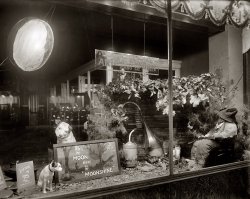
- Smart Clothes: 1910
- ... right center. Once again, I can almost hear some nascent jazz somewhere down the street.
Are these women doing anything? Are ... Posted by Dave - 02/06/2014 - 2:08pm -
![Smart Clothes: 1910 Canal Street in New Orleans circa 1910. Large building is the Maison Blanche department store. 8x10 inch glass negative, exposed about six minutes before this image, posted here three years ago. Detroit Publishing Co. View full size.
I had to do itLeapin' Lazard's, sorry.
Glad=U=KumI count a total of 10 streetcars in less than two blocks. However, I wondered what the Glad=U=Kum sign was supposed to signify. So I did a Google search and once again, Shorpy comes up with the answer.
Subtle differencesIt looks like this photo was taken the day after the first photo. Probably because the first photo was out of focus. Notice the awnings on the building in front of the department store are different, puddles have evaporated and the traffic officer is suddenly missing.
[The other photo is not out of focus, the puddles are the same in each picture, and the same horse is at the curb in both photos. - Dave]
WOWLots of incredibly detailed photos here on Shorpy, but this has to be one of the best. I especially like the Luzianne Coffee sign on top of Williams' Pharmacy and the New Orleans Railway and Light Company station at right center. Once again, I can almost hear some nascent jazz somewhere down the street.
Are these women doing anything?Are these women handing leaflets out? The two women standing back to back look like they are wearing sashes and they all look like they are holding papers. What do you think??
Adler's still thereAdler's jewelry store is still open at this location, although they have expanded into the building lakeward.
Adler's was founded in 1898, located at Royal and Iberville in the French Quarter. They moved to 1810 Canal street and to the present location in 1909 (putting a maximum age on the photo). The clock is a local landmark and still present, but without the pedestal - it's now supported by some steel beams from the overhang. Coleman E. Adler III currently runs the business started by his great grandfather.
Most of the other buildings in the photo also remain.
Adler's JewelersAppears to be in the same place. However, the clock in front of the store is no longer on a post. There's also a Mercedes where the horse and buggy were once parked:
View Larger Map
(The Gallery, New Orleans, Stores & Markets, Streetcars)](https://www.shorpy.com/files/images/SHORPY_4a23684a.thumbnail.jpg)
- Whorls and Ridges: 1925
- ... Brooks jms? That hair cut and drop waist dress screams jazz age!
Sparse Furnishings! The room is rather bare, the desks look ... Posted by Dave - 03/18/2013 - 4:27pm -
![Whorls and Ridges: 1925 Washington, D.C., 1925. "Justice Department, Nat'l. Bureau of Identification." Filing fingerprints at the forerunner of today's FBI. View full size.
Until J. Edgar Hoover took overThe Justice Department's Bureau of Investigation was nothing to brag about. Almost anyone with connections could be a field agent, and the quality of the furniture in this photo reflects the Bureau's stature in the Federal bureauacy. Agents were poorly paid, poorly trained and had to depend on public transportation to get to the scene of the crime. Hoover changed all that, eventually turning a lowly haven for slackers into the world's greatest criminal investigative force, the Federal Bureau of Investigation. Hoover had just started as Director when this picture was taken. A few years down the line, a cigarette butt on the office floor could lead to a 10-day suspension!
The girl on the leftThe first thing I noticed was the unusual haircut and clothing style of the young woman on the left for the time. The other three people in this picture look very 1925, but the left-hand woman looks like she's out of 1960s London.
Hard at WorkThere they are looking for Anarchists, Bolsheviks and any others looking to overthrow the status quo.
The girl on the left, 2Haven't you ever heard of Lulu Brooks jms? That hair cut and drop waist dress screams jazz age!
Sparse Furnishings!The room is rather bare, the desks look very old and scratched and have been placed next to the windows to take advantage of the natural lighting.
The Bureau did not seem to spend a lot of money on workplace amenities. Is that is a cigarette on the floor by the girl on the left (no ashtray on their desk!) although the men seem to have one.
Guess I'm spoiled and greedyI couldn't imagine having to share my desk with somebody else. That's some mighty close quarters, there!
Working in the backI find the double-sided desks most interesting. I can see the woman on the far left has drawers, but unless the man in the middle has some on the opposite side from the way her desk is built, he just gets to work on the backside of the other guy's desk.
WinterLooks like a cold, snowy day outside.
Name?Lulu? You perhaps mean Louise Brooks?
[It's her common nickname, used by herself in fact, in her memoir Lulu in Hollywood. - tterrace]
(The Gallery, D.C., Natl Photo, The Office)](https://www.shorpy.com/files/images/SHORPY_32231u.thumbnail.jpg)
- Radio Radio: 1924
- ... Commerce Commission building." Two doors down from the Jazz Age equivalent of the Apple Store. Note police call box with Bat Signal ... Posted by Dave - 01/10/2013 - 10:10pm -
![Radio Radio: 1924 Washington, D.C., 1924. "Interstate Commerce Commission building." Two doors down from the Jazz Age equivalent of the Apple Store. Note police call box with Bat Signal globe. Harris & Ewing Collection glass negative. View full size.
Call him FuzzyThe Ghost in the middle was probably running to escape the Mold eating the near side of the street.
ReflectionsThe base of the "Bat Signal" seems to be scratched up or dirty, but most of the globe is quite reflective. It shows us the buildings across the street (behind the camera), as well as possibly a glimpse of the photographer (or maybe just the top of the photographic equipment). If only the entire globe was shiny...
Call Box??By the handle on front, I would say this is for fire call. Police call boxes I have seen have a plainer, near flat tront door. I wonder if the globe was lit at night with the street lights.
[We've seen these before; it's a police call box. - tterrace]
The police box in your cite is a different shape. With the obvious large handle on the front and the peaked roof design I will still believe it is a alarm box for citizens to report a fire.
Tandem Fire/Police Alarm BoxI'm pretty sure the alarm box pedestal is a tandem fire and police emergency alarm box. The side facing the camera is a classic Gamewell design with the glass covered dog house door handle to gain access to the inner alarm pull handle. On the other side the roof and the door hinges are visible for an identical alarm box. I believe one box is painted red, the other blue with each respective box sending its signal to the appropriate agency. A call box with a phone normally would not have the glass covered dog house, but instead have a simple keyed door.
Back to back?Charlie B: I think you and tterrace may both be right.
San Francisco still has similar call box arrangements with back-to-back boxes for both police AND fire departments. Given the depth of the box(es) in this photo I think that'w what's going on here.
Check out the attached photo, albeit without the bracket and all-seeing eye orb.
Dueling Signal BoxesAt first I thought that the 12 years between pictures might account for the style difference, but then I came across Anton Michael's photos of modern Washington D.C. with side-by-side surviving call boxes across from Lafayette Square at Jackson Place and Pennsylvania Avenue.
The picture (used with permission) shows the back side of the fire call box with its locked door that was accessible only to the Fire Chief. Inside this half of the box was a telegraph key and receiver that could send an order for a second alarm.
Gas lamps were originally on top of the poles as seen below, but these were eventually replaced by the globes which, in turn, were replaced by the less vandal-tempting caged lights mounted on shortened poles.
A brief history of the Washington D.C. call boxes can be found here.
Call Box?? RevisitedThanks to Larmo for pointing out the obvious features of the opposite box. The site following has a history of D.C. alarm boxes. They don't show back to back, but it is interesting.
http://househistoryman.blogspot.com/2012/02/history-of-washington-dc-pol...
Reflections...of IvySplunge...I noted your unequal zoomed in photo of the globe. Might I suggest that the globe is indeed shiny and the lower part of the globe isn't scratched, but is reflecting the ivy or other plants in the lower right hand corner of the original view of the photo?
Still, the zoomed view provides a glimpse into the past that I would bet my life the original photographer never imagined we today would be focusing in and looking behind the field of view of the camera.
Southern Hemisphere@MrK - I considered that. You may be right, of course, but the reflection in question is fairly consistent from left-to-right and all the way to the bottom of the sphere, which would suggest that the ivy would run right up to the call box (which doesn't seem to be the case, given the visible sidewalk) and along a good-sized length of the street (not to mention *into* the street). Perhaps the reflection in the lower right is lightened or otherwise affected by the ivy, but to me, the rather abrupt loss of detail just south of the "equator" still suggests crusted dirt or blemishes on the globe's surface.
As for unintended reflections, they are a particular favorite of mine: see also https://www.shorpy.com/node/12105.
(The Gallery, D.C., Harris + Ewing)](https://www.shorpy.com/files/images/SHORPY_14492a.thumbnail.jpg)
- Dwarfed: 1941
- ... were gumbo, fried shrimp, and hot dogs. Although big-name jazz and blues performers were often showcased at Tony's Tavern, lesser-known ... Posted by Dave - 12/09/2018 - 10:30pm -
![Dwarfed: 1941 April 1941. "South Side Chicago. Scene in Negro tavern." The walls adorned with murals from the Disney version of "Snow White." Medium format negative by Russell Lee for the Farm Security Administration. View full size.
Every girl crazy'bout a sharp dressed (and manicured) man.
Our front-and-center couple are enjoying what in Detroit (and maybe Chicago) we called a "boomba".
Man-icuredThat fellow in the middle has more delicate fingers and nails than the ladies on either side of him.
What classGo out for a sandwich and a beer, dressed to the nines. Back then people took pride in their appearance.
Just like meThat lady on the right must be watching her carbs. She left her crust.
Hat CheckThe men in my family were taught to remove hats before taking a seat. (Quite a few, er ... confrontations with my own son with regard to this social faux pas.) Perhaps the dapper folks in Chicago didn't get the memo?
[Perhaps you've never been to Chicago. - Dave]
A pickerRegarding the nails on the man in the center with the beer. I bet he was a guitar picker, left handed.
Tony's Tavern"Russell Lee took this photograph on April 6, 1941, at Tony's Tavern. Located at Thirty-first and Federal Streets in Chicago, the heart of a neighborhood called Bronzeville, Tony's Tavern opened around 1900. Its owner, Tony Finkelstein, hosted some music legends—Louis Armstrong, Cab Calloway, Duke Ellington, and Estelle and Jimmy Yancey. Menu specialties of the house were gumbo, fried shrimp, and hot dogs. Although big-name jazz and blues performers were often showcased at Tony's Tavern, lesser-known groups were also welcome, such as the one shown here. The painted mural of Walt Disney's Snow White and the Seven Dwarfs was used as an identity backdrop for photograph sessions."
From Images of America - Chicago Blues - By Wilbert Jones
We visited this place before - Cafe Society: 1941
Low on CamelsLooks like there may only be a one or two left in that pack. Better scare up 12 cents for another.
(The Gallery, Chicago, Eateries & Bars, Russell Lee)](https://www.shorpy.com/files/images/SHORPY-8c00683a.thumbnail.jpg)























